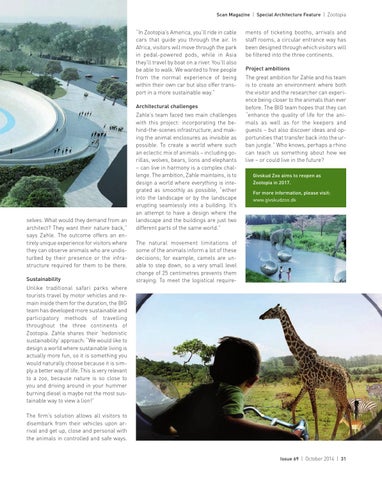2_1_ScanMag_69_Oct_2014_Text:Scan Magazine 1
6/10/14
11:59
Page 31
Scan Magazine | Special Architecture Feature | Zootopia
“In Zootopia’s America, you’ll ride in cable cars that guide you through the air. In Africa, visitors will move through the park in pedal-powered pods, while in Asia they’ll travel by boat on a river. You’ll also be able to walk. We wanted to free people from the normal experience of being within their own car but also offer transport in a more sustainable way.” Architectural challenges
selves. What would they demand from an architect? They want their nature back,” says Zahle. The outcome offers an entirely unique experience for visitors where they can observe animals who are undisturbed by their presence or the infrastructure required for them to be there. Sustainability
Zahle’s team faced two main challenges with this project: incorporating the behind-the-scenes infrastructure, and making the animal enclosures as invisible as possible. To create a world where such an eclectic mix of animals – including gorillas, wolves, bears, lions and elephants – can live in harmony is a complex challenge. The ambition, Zahle maintains, is to design a world where everything is integrated as smoothly as possible, “either into the landscape or by the landscape erupting seamlessly into a building. It’s an attempt to have a design where the landscape and the buildings are just two different parts of the same world.”
ments of ticketing booths, arrivals and staff rooms, a circular entrance way has been designed through which visitors will be filtered into the three continents. Project ambitions The great ambition for Zahle and his team is to create an environment where both the visitor and the researcher can experience being closer to the animals than ever before. The BIG team hopes that they can “enhance the quality of life for the animals as well as for the keepers and guests – but also discover ideas and opportunities that transfer back into the urban jungle.” Who knows, perhaps a rhino can teach us something about how we live – or could live in the future? Givskud Zoo aims to reopen as Zootopia in 2017. For more information, please visit: www.givskudzoo.dk
The natural movement limitations of some of the animals inform a lot of these decisions; for example, camels are unable to step down, so a very small level change of 25 centimetres prevents them straying. To meet the logistical require-
Unlike traditional safari parks where tourists travel by motor vehicles and remain inside them for the duration, the BIG team has developed more sustainable and participatory methods of travelling throughout the three continents of Zootopia. Zahle shares their ‘hedonistic sustainability’ approach: “We would like to design a world where sustainable living is actually more fun, so it is something you would naturally choose because it is simply a better way of life. This is very relevant to a zoo, because nature is so close to you and driving around in your hummer burning diesel is maybe not the most sustainable way to view a lion!” The firm’s solution allows all visitors to disembark from their vehicles upon arrival and get up, close and personal with the animals in controlled and safe ways.
Issue 69 | October 2014 | 31
